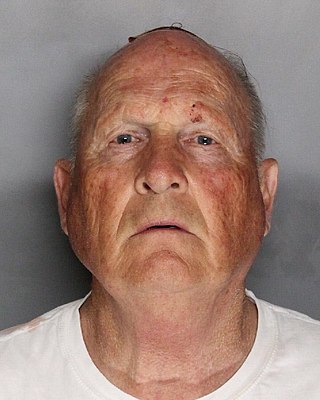Related Research Articles

Joseph James DeAngelo Jr. is an American serial killer, serial rapist, burglar, peeping tom, former police officer, and former mechanic who committed at least 13 murders, 51 rapes, and 120 burglaries across California between 1974 and 1986. He is responsible for three known separate crime sprees throughout the state, each of which spawned a different nickname in the press, before it became evident that they were committed by the same person.

Robert Tyrone Hayes is an American serial killer who has been convicted of three murders in the Daytona Beach, Florida, area between December 2005 and February 2006. DNA tests have also linked him to a fourth murder committed in March 2016. In addition, he remains the prime suspect in the murder of another woman in December 2007.

FamilyTreeDNA is a division of Gene by Gene, a commercial genetic testing company based in Houston, Texas. FamilyTreeDNA offers analysis of autosomal DNA, Y-DNA, and mitochondrial DNA to individuals for genealogical purpose. With a database of more than two million records, it is the most popular company worldwide for Y-DNA and mitochondrial DNA, and the fourth most popular for autosomal DNA. In Europe, it is the most common also for autosomal DNA. FamilyTreeDNA as a division of Gene by Gene were acquired by MYDNA, Inc., an Australian company, in January 2021.
Colleen M. Fitzpatrick is an American forensic scientist, genealogist and entrepreneur. She helped identify remains found in the crash site of Northwest Flight 4422, that crashed in Alaska in 1948, and co-founded the DNA Doe Project which identifies previously unidentified bodies and runs Identifinders International, an investigative genetic genealogy consulting firm which helps identify victims and perpetrators of violent crimes.

The Bear Brook murders are female American murder victims, two discovered in 1985 and two in 2000, at Bear Brook State Park in Allenstown, New Hampshire, United States. All four of the victims were either partially or completely skeletonized; they were believed to have died between 1977 and 1981.

Amy Marie Yeary was an American woman whose body was discovered on November 23, 2008, near Campbellsport, Fond du Lac County, Wisconsin. Her body remained unidentified for 13 years before investigators announced her identification via forensic genealogy and dental records on November 23, 2021.

Tammy Corrine Terrell was an American murder victim from Roswell, New Mexico. Her body was discovered on October 5, 1980, in Henderson, Nevada, and remained unidentified until December 2021. Her case has been the subject of extensive efforts by investigators and has been highlighted as inspiring other work to solve cold cases of unidentified murder victims.

CeCe Moore is an American genetic genealogist who has been described as the country's foremost such entrepreneur. She has appeared on many TV shows and worked as a genetic genealogy researcher for others such as Finding Your Roots. She has reportedly helped law enforcement agencies in identifying suspects in over 300 cold cases using DNA and genetic genealogy. In May 2020, she began appearing in a prime time ABC television series called The Genetic Detective in which each episode recounts a cold case she helped solve. In addition to her television work, she is known for pioneering the genetic genealogy methodologies used by adoptees and others of unknown origin for identifying biological family.

Investigative genetic genealogy, also known as forensic genetic genealogy, is the emerging practice of utilizing genetic information from direct-to-consumer companies for identifying suspects or victims in criminal cases. As of December 2023, the use of this technology has solved a total of 651 criminal cases, including 318 individual perpetrators who were brought to light. There have also been 464 decedents identified, as well as 4 living Does. The investigative power of genetic genealogy revolves around the use of publicly accessible genealogy databases such as GEDMatch and FamilyTreeDNA. On GEDMatch, users are able to upload their genetic data from any direct-to-consumer company in an effort to identify relatives that have tested at companies other than their own.

Terry Peder Rasmussen was an American convicted murderer and suspected serial killer who was convicted of one murder, and linked to at least five more in a series of crimes that stretched across the contiguous United States between 1978 and 2002. Due to his use of many aliases, most notably "Bob Evans", Rasmussen is known as the Chameleon Killer.
Parabon NanoLabs, Inc. is a company based in Reston, Virginia, that develops nanopharmaceuticals and provides DNA phenotyping services for law enforcement organizations.

GEDmatch is an online service to compare autosomal DNA data files from different testing companies. It is owned by Qiagen.

DNA Doe Project is an American nonprofit volunteer organization formed to identify unidentified deceased persons using forensic genealogy. Volunteers identify victims of automobile accidents, homicide, and unusual circumstances and persons who committed suicide under an alias. The group was founded in 2017 by Colleen M. Fitzpatrick and Margaret Press.

Paul Holes is an American former cold-case investigator for the Contra Costa County Sheriff's Office. Holes is known for his contributions to solving the Golden State Killer case using advanced methods of identifying the killer with DNA and genealogy technology. Since retiring in March 2018, Holes has contributed to books, television, and podcasts about the Golden State Killer and true crime.

Mary Edith Silvani, known as "Sheep's Flat Jane Doe" and "Washoe County Jane Doe" while unidentified, was an American woman found shot to death near Lake Tahoe in Washoe County, Nevada in July 1982. She was unidentified for 37 years, the investigation becoming a cold case. The Washoe County Sheriff's Office announced her identity on May 7, 2019. Silvani was identified through DNA analysis and genetic genealogy with assistance from the DNA Doe Project and utilizing the public genealogy database GEDmatch.

Robert "Bobby" Adam Whitt and Myoung Hwa Cho were two formerly unidentified murder victims who were killed in 1998. They remained unidentified until they were both identified using GEDmatch in early 2019. While unidentified, Whitt was nicknamed Mebane Child and the Boy Under the Billboard.
The rape and murder of Angie Dodge occurred in Idaho Falls, Idaho on June 13, 1996. However, the true perpetrator was not apprehended until May 2019.

Traci Lynn Hammerberg was an 18-year-old American who was killed on December 15, 1984. Her murderer was identified in 2019 through forensic genealogy.
Othram is an American corporation specializing in forensic genetic genealogy to resolve unsolved murders, disappearances, and identification of unidentified decedents or murder victims. The company also offers law enforcement agencies tools and programs to infer kinship among individuals, both closely and distantly related, through a combination of short tandem repeat and single nucleotide polymorphism testing, as well as forensic genome sequencing of DNA.

Elizabeth "Lisa" Ann Roberts, otherwise known as Precious Jane Doe, was an American homicide victim found near Everett, Washington on August 14, 1977, who was an unidentified decedent for 43 years until being identified on June 16, 2020. She had been picked up by a male driver while hitchhiking and killed after refusing sex. Her assailant had strangled her with a cord and then emptied his gun into her head, complicating identification. Roberts was a teen runaway who left her Oregon home in July 1977, less than a month before her murder. She was given the nickname "Precious Jane Doe" by Detective Jim Scharf, who began investigating the case in 2008. The detective was quoted as saying, "This young girl was precious to me because her moral decision from her proper upbringing cost her her life [...] I knew she had to be precious to her family too, so I had to find them. We needed to give her name back to her and return her remains to her family." Roberts was 17 at the time of her murder, though initial police estimations of her age were much older. Her body was found by blackberry pickers, and the medical examiner determined she had been dead for approximately 5 days before discovery. She was discovered fully clothed in a pastel tank top and denim cutoffs. As her identity remained unknown, Roberts' case was relegated as a cold case. In 2020, genetic testing via hair samples was used to locate her biological family, who led to her adoptive family.
References
- 1 2 3 4 American Men & Women of Science (26th ed.). Gale. 2009. pp. 25–26. ISBN 9781414433004.
- 1 2 Hampton, Simon (October 2018). "How a Kiwi helped solve the US' greatest cold case" (PDF). Te Awamutu Branch of the New Zealand Society of Genealogists Newsletter. No. 298. p. 6. Archived from the original (PDF) on February 1, 2020. Retrieved December 30, 2018.
- 1 2 3 Tron, Gina (August 18, 2018). "Who Is Dr. Barbara Rae-Venter And How Did She Help Catch The Golden State Killer Suspect?". Oxygen. Archived from the original on November 28, 2019. Retrieved September 13, 2019.
- 1 2 3 4 5 6 7 Murphy, Heather (August 29, 2018). "She Helped Crack the Golden State Killer Case". New York Times. Archived from the original on September 4, 2018. Retrieved December 19, 2018.
- ↑ Reinhold, Robert (January 7, 1990). "Science Under Scrutiny; Losing the Race". The New York Times.
- ↑ Murphy, Heather (May 12, 2019). "The women who pioneered the use of DNA websites to unlock cold cases". The Independent. Archived from the original on September 26, 2019. Retrieved September 13, 2019.
- ↑ "Teachers, Assistants & Course Leaders". DNAAdoption.org. Archived from the original on March 29, 2019. Retrieved February 23, 2019.
- 1 2 Maher, Brenden. "Nature's 10". Nature. Archived from the original on October 15, 2020. Retrieved March 11, 2019.
- ↑ Holes, Paul (April 16, 2019). "Barbara Rae-Venter". TIME. Archived from the original on May 6, 2019. Retrieved May 5, 2019.
- 1 2 Augenstein, Seth (February 7, 2017). "The Tale of the Abandoned Girl's DNA that Led to a Notorious Cold Case". Forensic Magazine. Archived from the original on May 10, 2019. Retrieved February 20, 2019.
- ↑ Corum, Jonathan and Murphy, Heather (October 15, 2018). "How Genetic Sleuthing Helped a Kidnapped Girl Recover Her Identity". The New York Times. Archived from the original on March 8, 2019. Retrieved March 11, 2019.
{{cite web}}: CS1 maint: multiple names: authors list (link) - 1 2 3 4 5 Gafni, Matthias (August 24, 2018). "The woman behind the scenes who helped capture the Golden State Killer". The Mercury News . Archived from the original on April 15, 2019. Retrieved February 23, 2019.
- ↑ Aaro, David (June 9, 2019). "Librarian helps ID cold case murder victims killed between 1985-2000". Fox News. Archived from the original on August 19, 2019. Retrieved September 13, 2019.
- ↑ Chavez, Nicole (June 2, 2016). "DNA that led to Golden State Killer suspect's arrest was collected from his car while he shopped". CNN. Archived from the original on February 5, 2019. Retrieved February 23, 2019.
- ↑ Lee, Amber (August 30, 2018). "Critical genealogist in Golden State Killer case speaks out about her role". KTVU. Archived from the original on March 10, 2019. Retrieved March 11, 2019.
- ↑ "Ancestry DNA leads to identity of boy whose remains were found in 1998". ABC6. February 5, 2019. Archived from the original on February 6, 2019. Retrieved September 13, 2019.
- ↑ Venter, J. Craig (2007). A Life Decoded: My Genome, My Life . New York: Viking. pp. 43–48. ISBN 9780670063581. OCLC 165048736.
- ↑ Shampo, Marc A.; Kyle, Robert A. (2011). "J. Craig Venter—The Human Genome Project". Mayo Clinic Proceedings. 86 (4): e26–e27. doi:10.4065/mcp.2011.0160. ISSN 0025-6196. PMC 3068906 . PMID 21584979.